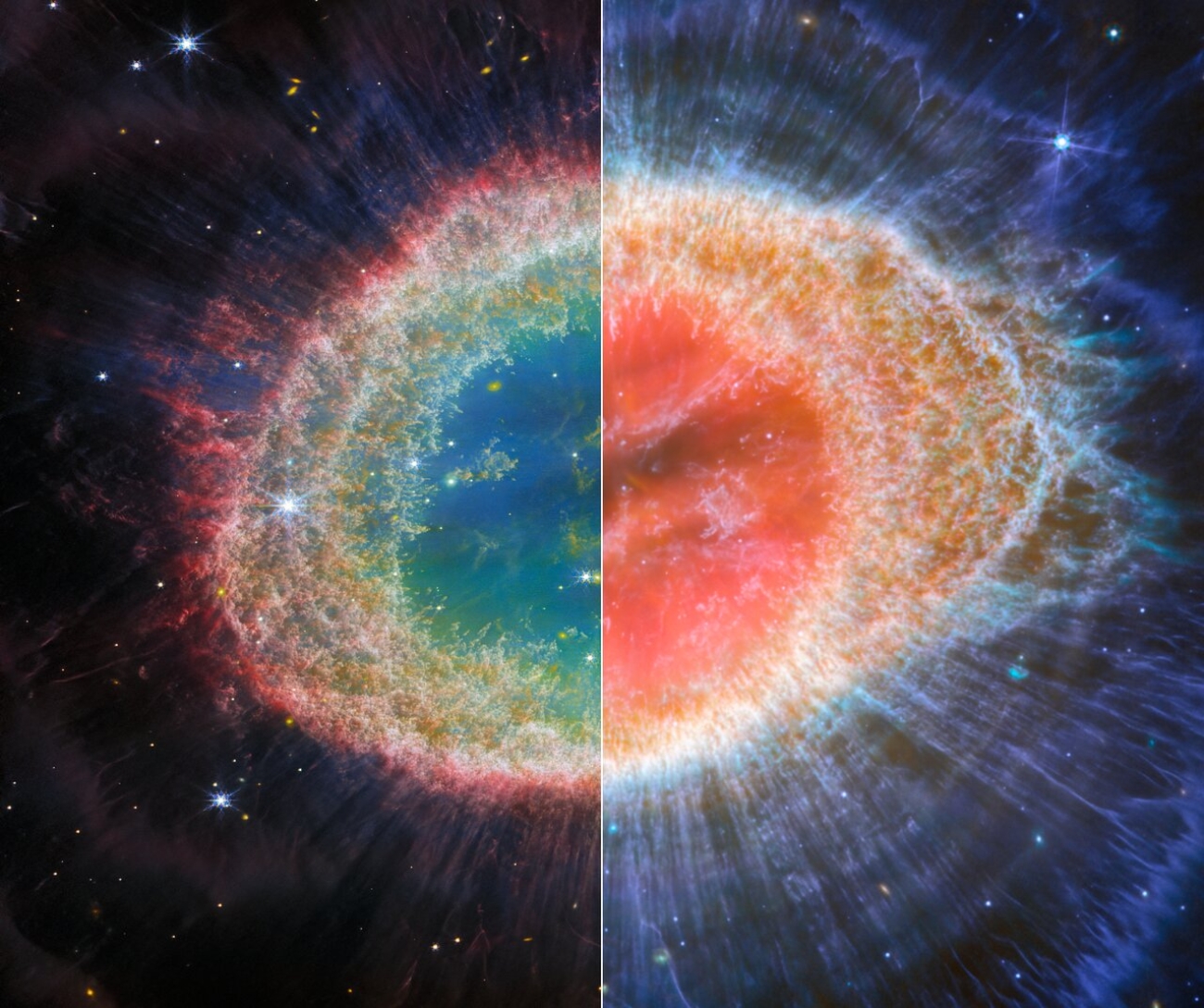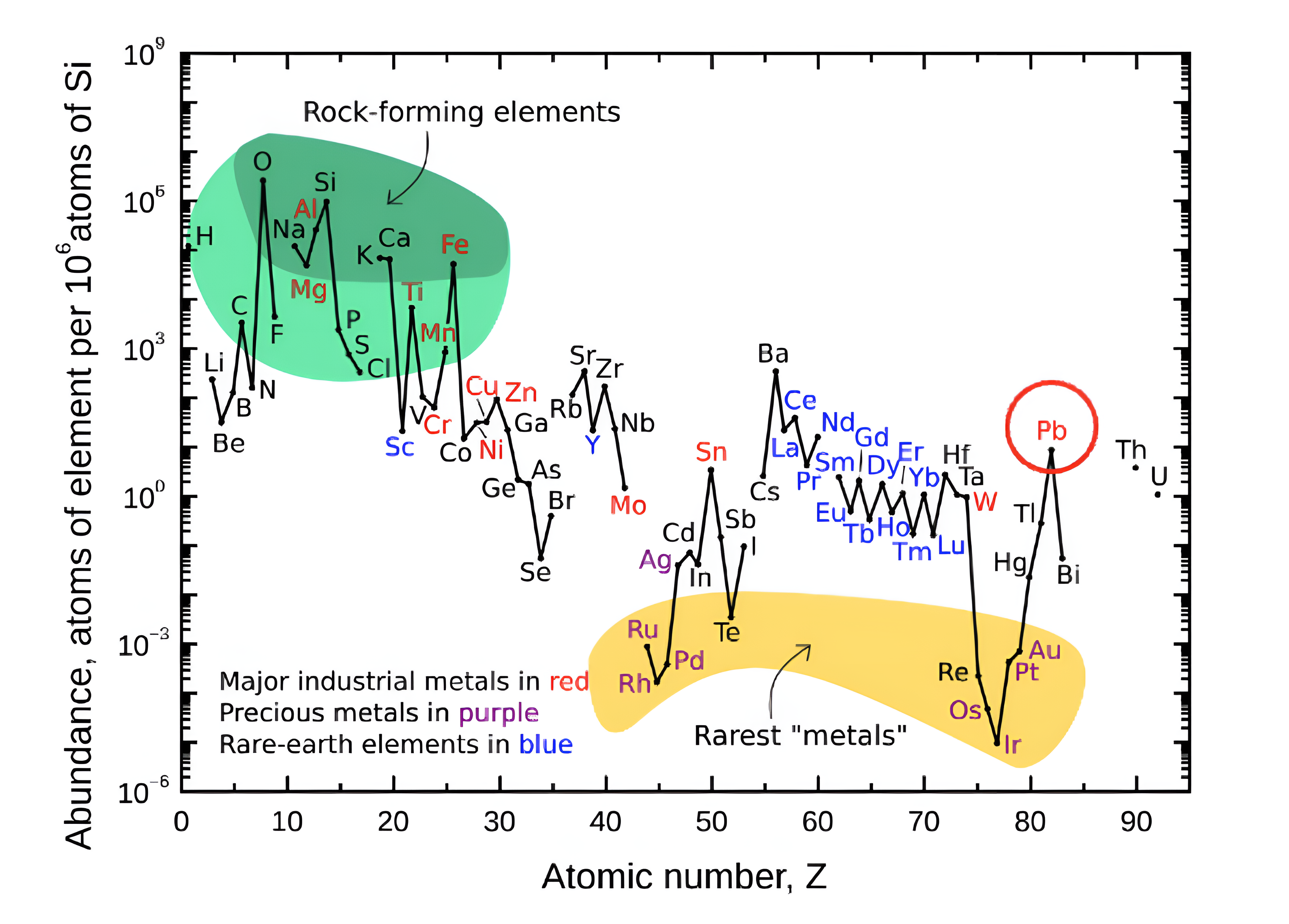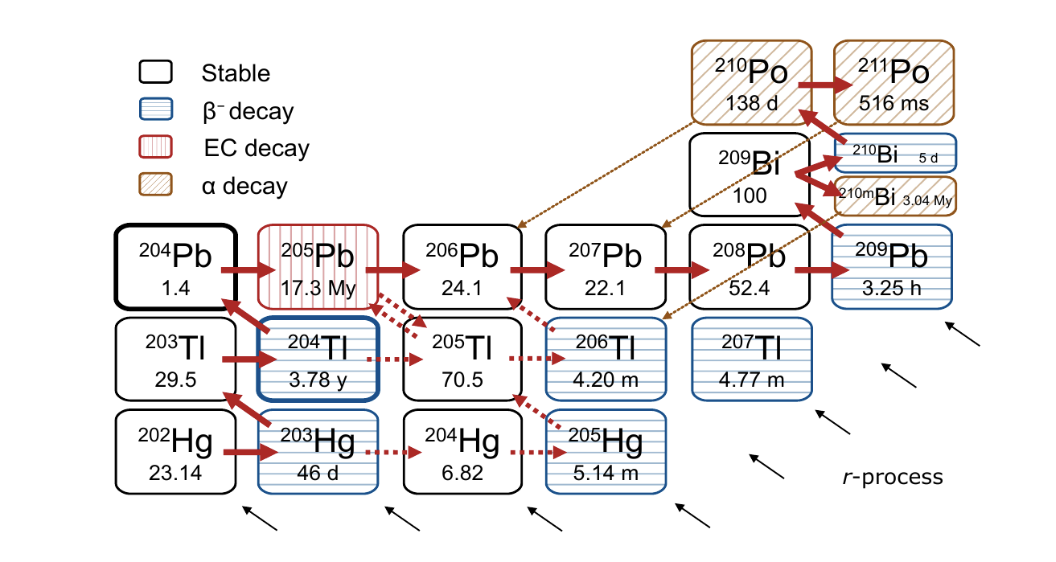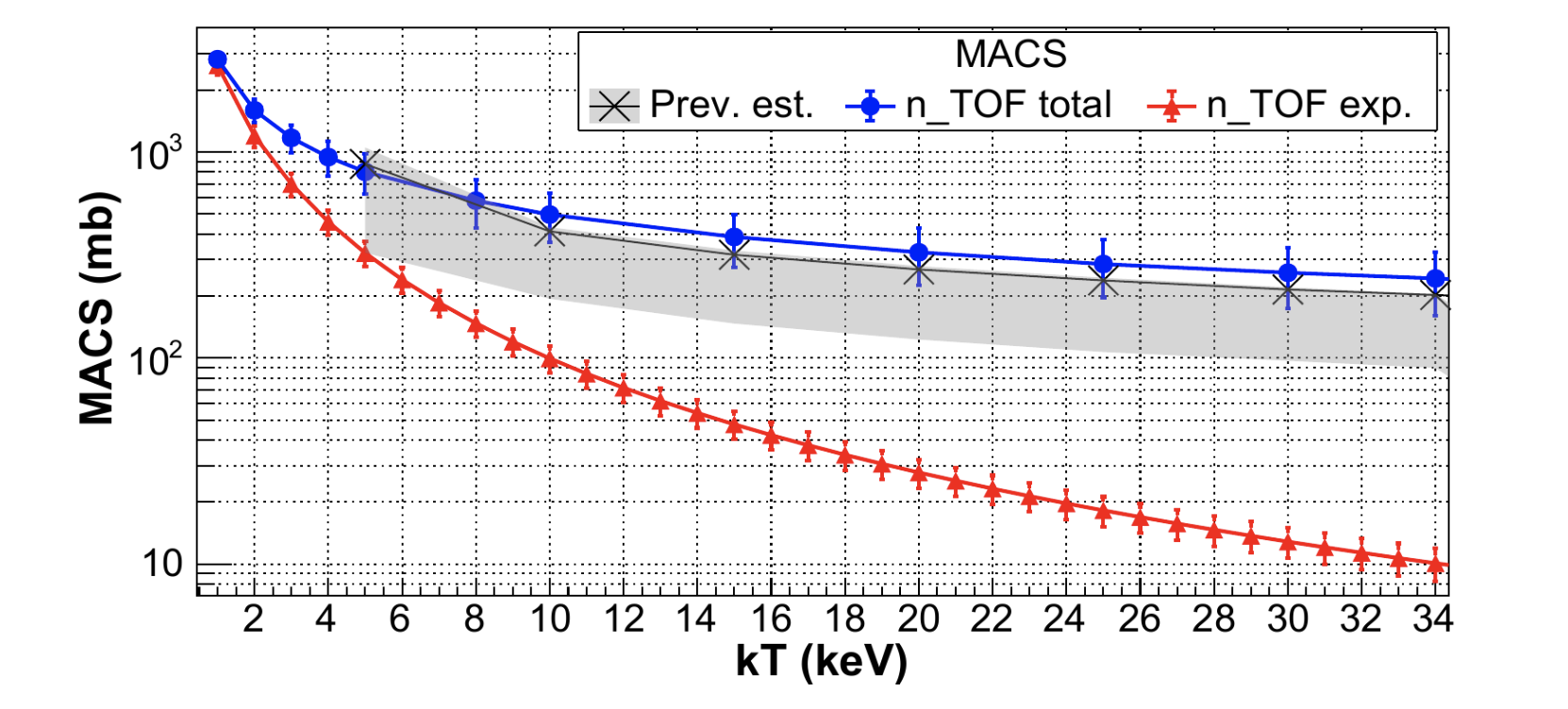The origin of Lead and the s-process branching points

Lead is an abundant element of the solar system and is particularly abundant on the Earth’s crust (Figure 1). The origin of three of its four stable isotopes (206Pb, 207Pb, and 208Pb) can be partially traced back to the decay of uranium and thorium (radiogenic origin) and, for the most part, by the neutron capture r- and s-processes nucleosynthesis. However, the fourth stable lead isotope, 204Pb, does not have any radiogenic origin. In fact, it has been quantified by Galactic Evolution Chemical (GCE) models that almost all of the 204Pb abundance at the time of the formation of the solar system originated from the s-process [1], which is known to take place during the asymptotic giant branch (AGB) stage of low mass (1.5 to 3 solar masses) stars [2].
The s-only isotopes such as 204Pb play a pivotal role in studying the s-process nucleosynthesis in AGB stars. This is because they can be used to benchmark state-of-the-art AGB models by comparing nucleosynthesis calculations with observed abundances of these nuclei, which in the case of heavy elements such as lead are obtained mainly from meteorites of the Ivuna-type carbonaceous (CI) chondrites(i) [3].
However, to obtain precise isotopic information from calculations it is necessary to know accurately the stellar-averaged capture (n,ɣ) cross section (Maxwellian-Averaged Cross Section, MACS) (ii), that regulate the production and destruction of all nuclei in the s-process path.

Figure 1: Earth crust abundance of the chemical elements (Source: Wikipedia).
Although theoretical models can be employed to estimate or constrain the capture cross sections, accurate data can only be obtained by experiments. In the case of 204Pb , whereas its neutron-capture cross section was already measured at n_TOF facility [4], a more accurate assessment had been hindered in the past by the lack of experimental nuclear data on its direct precursor nucleus, the radioactive 204Tl.
The s-process branching points: the case of 204Tl
Along the nucleosynthesis path, there are nuclei which are beta-unstable, but with half-lives comparable to the time scale of the neutron capture process. In these nuclei, the s-process flow is effectively split, and so they are commonly referred to as branching points in nucleosynthesis studies. The s-process abundance pattern of the nuclear species immediately following the branching point will be very sensitive to the ratio between capture and beta decay. This ratio is obviously much affected by the local neutron density and, in some particular cases, by the temperature of the stellar environment, an effect caused by the strong enhancement of the beta decay rate at these temperatures. These dependencies turn the isotopic patterns affected by the branching into valuable probes of the stellar environment where the s process occurs.

Figure 2: Schematic view of the chart of nuclei at the termination of the s process. The arrows correspond to the main s-process path, with dashed arrows depicting paths strongly enhanced during high temperature and high neutron density events.
In the case of 204Tl, the uncertainty in the strong thermal dependency of the β−decay rate [5], and most importantly, the lack of experimental data on its neutron capture cross-section, hampered a more accurate and precise knowledge of the s-process production of 204Pb.
At this point, it is clear that the radioactive nature of branching points makes them particularly relevant. However, it is also what makes experimenting on them equally challenging. Since the product of the 204Tl(n,ɣ) reaction is stable, the extremely sensitive activation technique can not be used, leaving the time-of-flight (TOF) technique as the only alternative.
The TOF technique allows measuring the energy dependence of the cross-section, and most importantly, the energy and magnitude of the resonances which characterize and dominate the overall capture cross-section of all but the lightest nuclear species. Nevertheless, this technique has much higher requirements in terms of neutron flux and minimum sample mass to perform viable measurements. In this regard, the high instantaneous neutron flux achieved in both n_TOF experimental areas makes it one of the best-suited facilities in the world for measuring radioactive samples.
Specifically, from the 21 key s-process branching nuclei discussed by Käppeler et al. [5], successful measurements have been conducted at n_TOF on 63Ni [6], 151Sm [7], 171Tm [8] and 79Se [9]. Of these nuclei, 171Tm has a very short half-life (1.92 yr) comparable to that of 204Tl of 3.78 y.
The measurement presented here was conducted at n_TOF-EAR1 [10]. Given its short half-life, 204Tl is not present in nature, and thus the sample for the experiment at n_TOF had to be produced from neutron irradiation of a seed sample of 203Tl. The irradiation was conducted in the high-flux reactor of the Institute Laue Langevin (Grenoble, France), and lasted 55 days. At the time of the experiment, the 204Tl concentration in the sample was 4%, which corresponded to a 204Tl total mass of only 9 mg.
There were multiple challenges to performing a TOF capture measurement on this sample. Although 9 mg of 204Tl might seem a minute quantity, it actually corresponds to 150 GBq or around 4 Ci of activity, a figure more typical of industrial radioactive sources than samples adequate for high precision nuclear experiments. The beta decay of 204Tl produced copious amounts of bremsstrahlung photons, in addition to gamma rays emitted by other contaminants. The neutron capture yield is measured by detecting the prompt deexcitation gamma rays emitted after each capture event by means of specifically designed scintillation detectors, and thus they had to be shielded to avoid damage or other undesirable effects from the sample radiation. The remaining background had to be carefully subtracted in the posterior data analysis.
It has to be noted that 96% of the sample was still 203Tl. In this sense, and thanks to the 185 m flight path, the high energy resolution of the n_TOF-EAR1 neutron beam was key to resolve the 204Tl capture resonances among the much more prominent ones of 203Tl.
The analysis of the experiment data allowed the first direct-ever measurement of several 204Tl(n,ɣ) resonances below neutron energies of 4 keV [10]. However, higher neutron energies are involved in s-process nucleosynthesis in low-mass AGB stars; depending on the neutron source reaction fuelling the process, thermal energies between kT≈8 keV and kT≈30 keV can be reached.

Figure 3: An example of the fit of a 204Tl(n,γ) resonance (solid red line) in the experimental data. This example illustrates how the high energy resolution of n_TOF-EAR1 made it possible to distinguish the 204Tl resonances from the 203Tl also present in the data (dashed green red line).
Therefore, the new results were complemented by semi-empirical calculations based on the new resonance data, yielding final MACS of 580(168) mb and 260(90) mb at the s-process temperatures of kT ≈ 8 keV and kT ≈ 30 keV, respectively. These figures are about 3% lower and 20% higher than the corresponding values widely used in nucleosynthesis simulations, which were based only on theoretical calculations.

Figure 4: The new 204Tl(n,γ) MACS, combining advanced statistical methods with the new resonance information obtained from the 204Tl(n,g) measurement at n_TOF.
Finally, to assess the impact of the new 204Tl(n,ɣ) MACS in the 204Pb s-process nucleosynthesis production, calculations were performed using the NuGrid postprocessing tools [11] applied to AGB stellar evolution simulations obtained with the code MESA [12].
The conclusions of these nucleosynthesis simulations were that, by using the new MACS, the uncertainty arising from the 204Tl(n,γ) cross-section on the s-process abundance of 204Pb has been reduced from ∼30% down to +8%/ − 6%, and the s-process calculations are in agreement with the latest solar 204Tl solar abundance of Pb reported by K. Lodders in 2021. Within the present experimental uncertainties, there is no need to invoke additional nucleosynthesis mechanisms or fractionation effects in order to explain the 204Pb abundance observed in the solar system.
Cover image: The NASA/ESA/CSA James Webb Space Telescope has observed the well-known Ring Nebula with unprecedented detail. Formed by a star throwing off its outer layers as it runs out of fuel, the Ring Nebula is an archetypal planetary nebula. The object is also known as M57 and NGC 6720, and is relatively close to Earth at roughly 2,500 light-years away.
Notes from the editors:
i) Ivuna is a carbonaceous chondrite (CI1) meteorite that fell in Mbeya, Tanzania, on the evening of December 16, 1938. While multiple stones may have fallen, only a single piece weighing 705 grams was recovered.
Ivuna serves as the type specimen for the CI chondrite group of meteorites, which are exceedingly rare—only nine are known to exist on Earth. CI meteorites are the most chemically primitive meteorites known, believed to have formed in the outer reaches of the solar nebula. These meteorites experienced minimal thermal alteration, never being heated above 50°C (122°F). They are uniquely characterized by the complete absence of chondrules and refractory inclusions, along with a high degree of hydration.
ii) It refers to the stellar-averaged neutron capture cross section, which is a critical parameter in nucleosynthesis studies. The MACS is determined by averaging the neutron capture cross section over a Maxwell-Boltzmann distribution of neutron velocities, representative of the thermal conditions in a stellar environment. This value regulates the production and destruction of nuclei in the s-process path, which is responsible for creating many of the heavy elements in stars.
References
- C. Travaglio, R. Gallino, M. Busso, and R. Gratton, Astrophys. J. 549, 346 (2001).
- F. Käppeler, R. Gallino, S. Bisterzo, and W. Aoki, Rev. Mod. Phys. 83, 157 (2011).
- K. Lodders, Space Sci. Rev. 217, 44 (2021).
- C. Domingo-Pardo et al. (n_TOF Collaboration), Phys. Rev. C 75, 015806 (2007).
- S.Goriely, Astron. Astrophys. 342, 881(1999).
- C. Lederer et al. (n_TOF Collaboration), Phys. Rev. Lett. 110, 022501 (2013).
- S. Marrone et al. (n_TOF Collaboration), Phys. Rev. C 73, 034604 (2006).
- C. Guerrero et al. (n_TOF Collaboration), Phys. Rev. Lett. 125, 142701 (2020).
- J. Lerendegui-Marco et al. (n_TOF Collaboration), EPJ Web Conf. 279, 13001 (2023).
- A. Casanovas-Hoste et al. (The n_TOF Collaboration). Phys. Rev. Lett. 133, 8 (2024).
- C. Ritter, F. Herwig, S. Jones, M. Pignatari, C. Fryer, and R. Hirschi, Mon. Not. R. Astron. Soc. 480, 538 (2018)
- B. Paxton, L. Bildsten, A. Dotter, F. Herwig, P. Lesaffre, and F. Timmes, Astrophys. J. Suppl. Ser. 192, 3 (2010)
